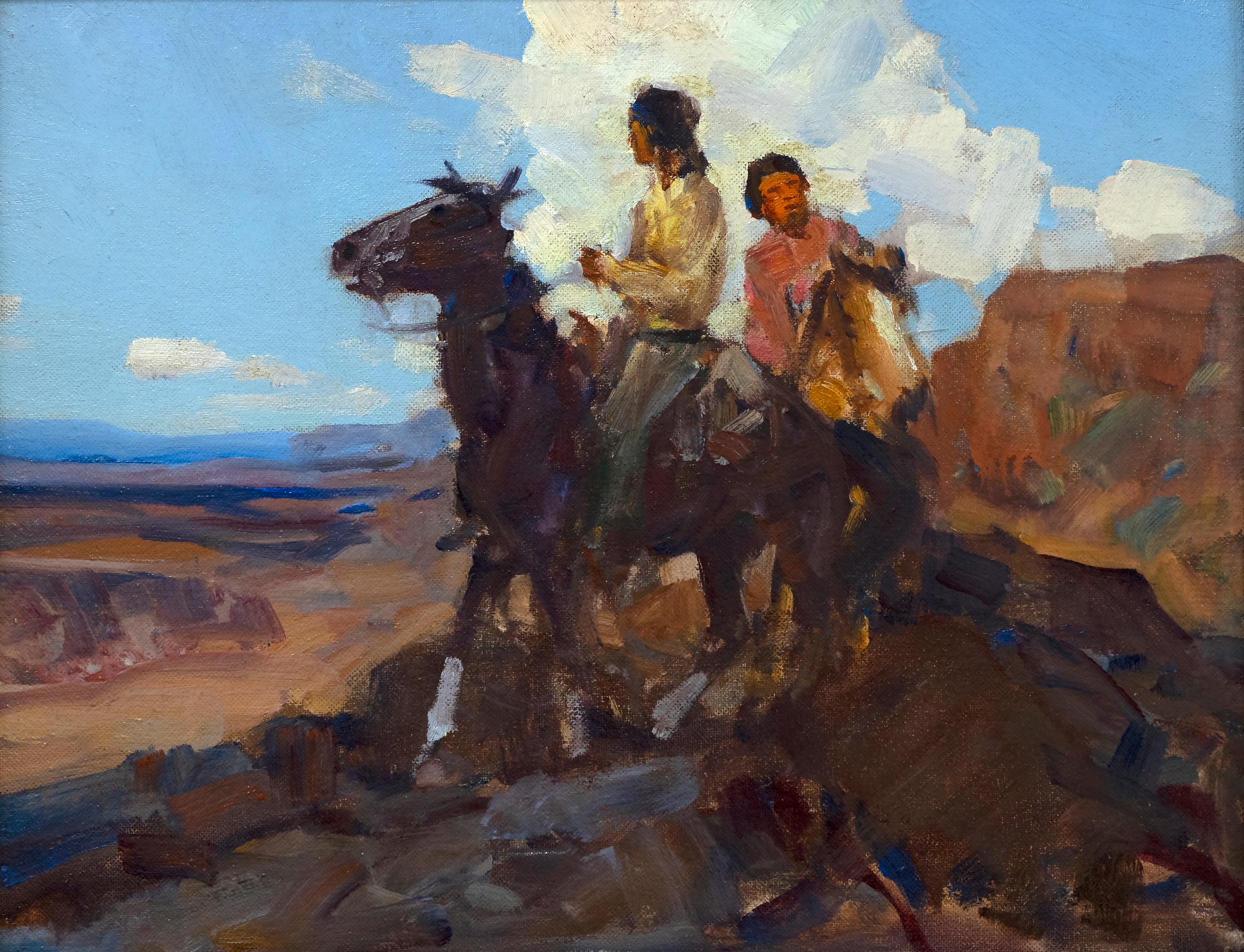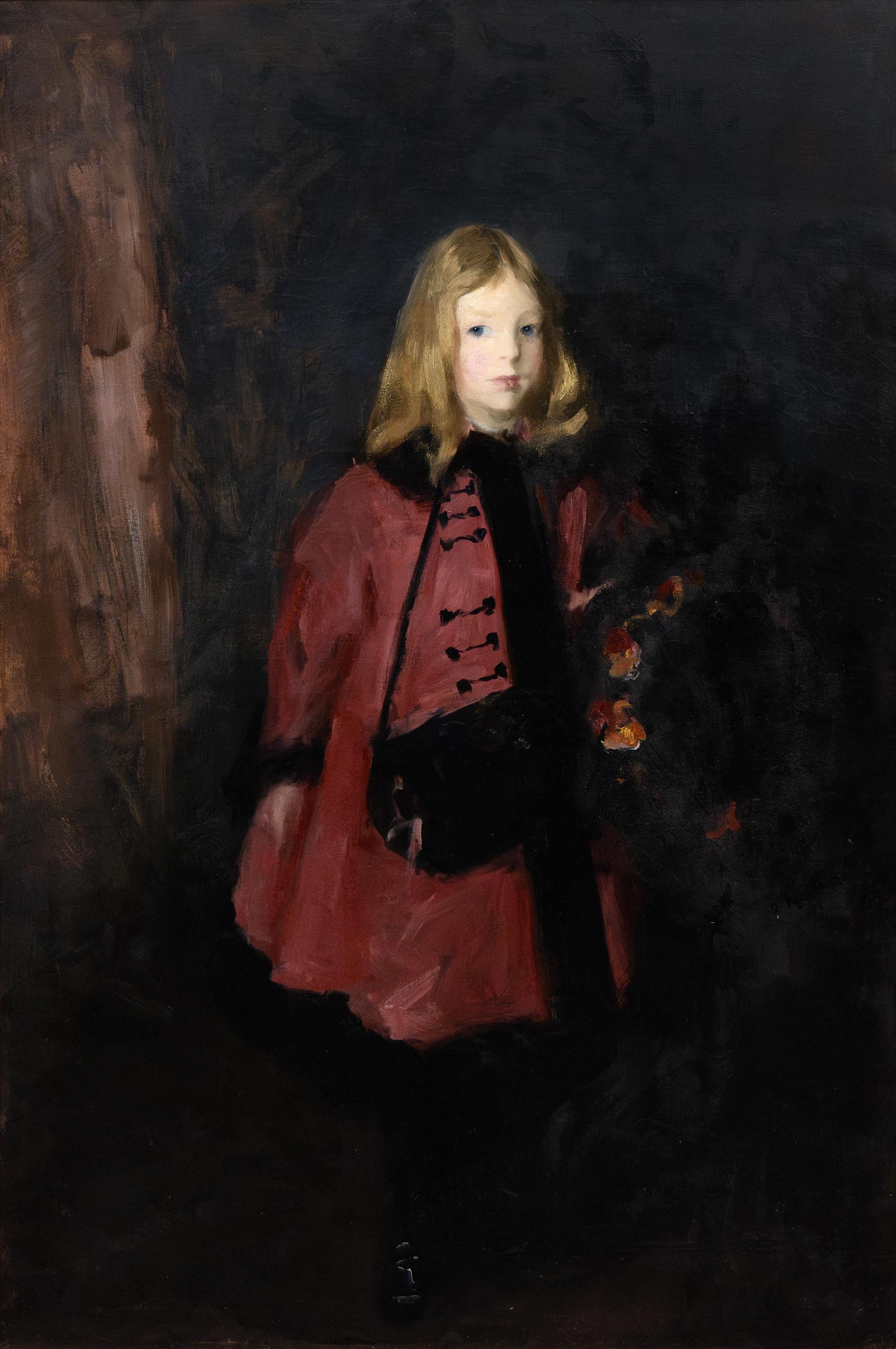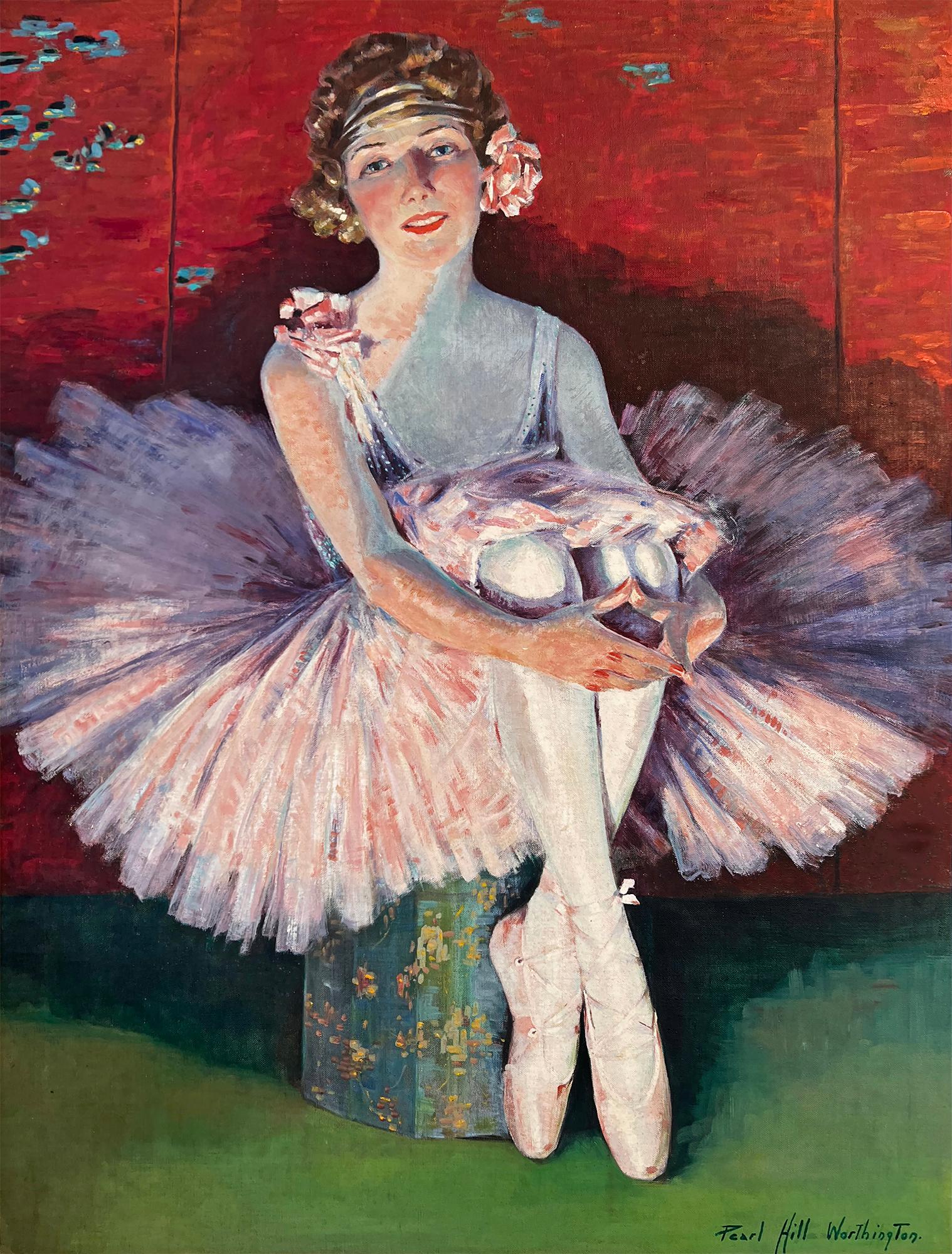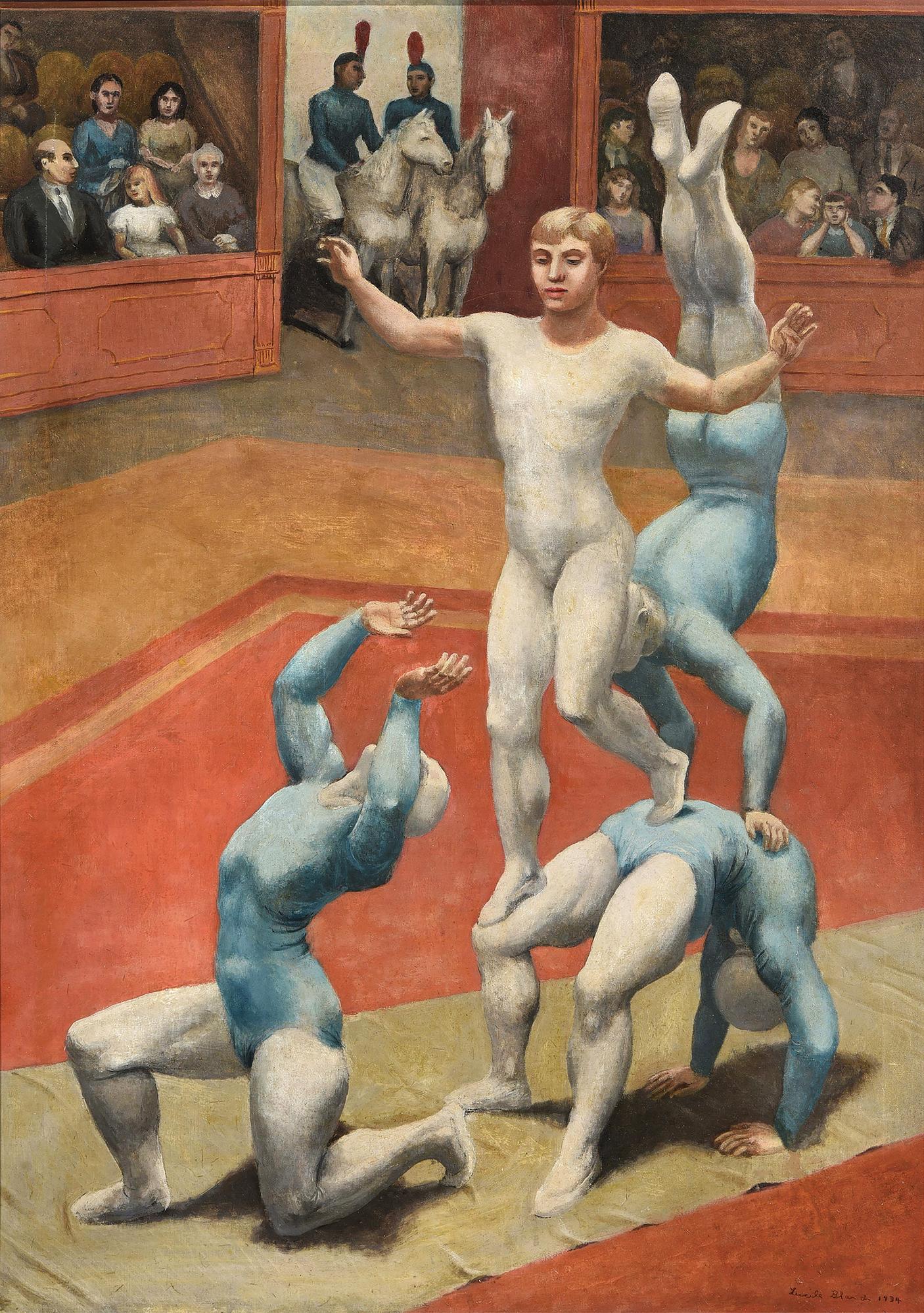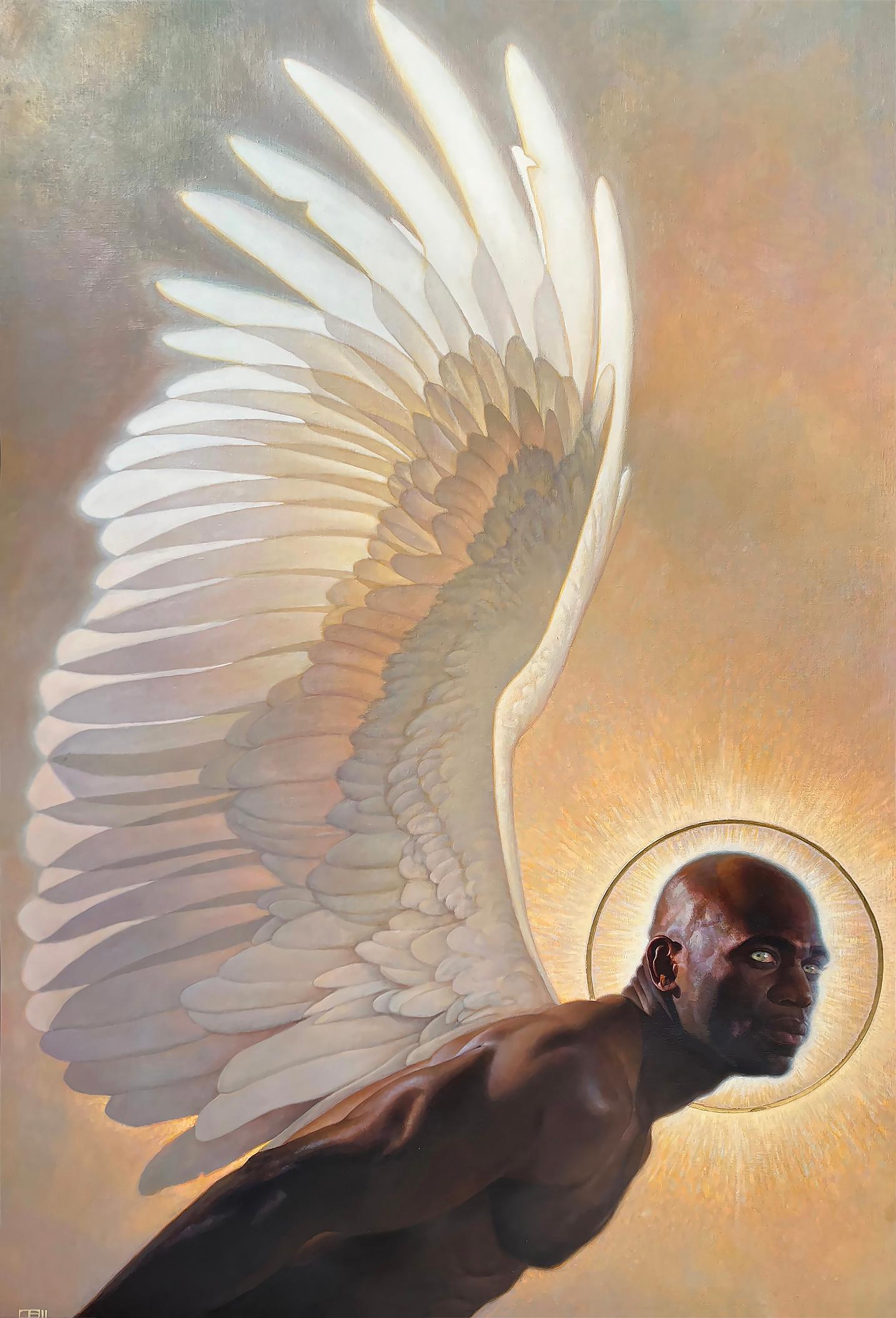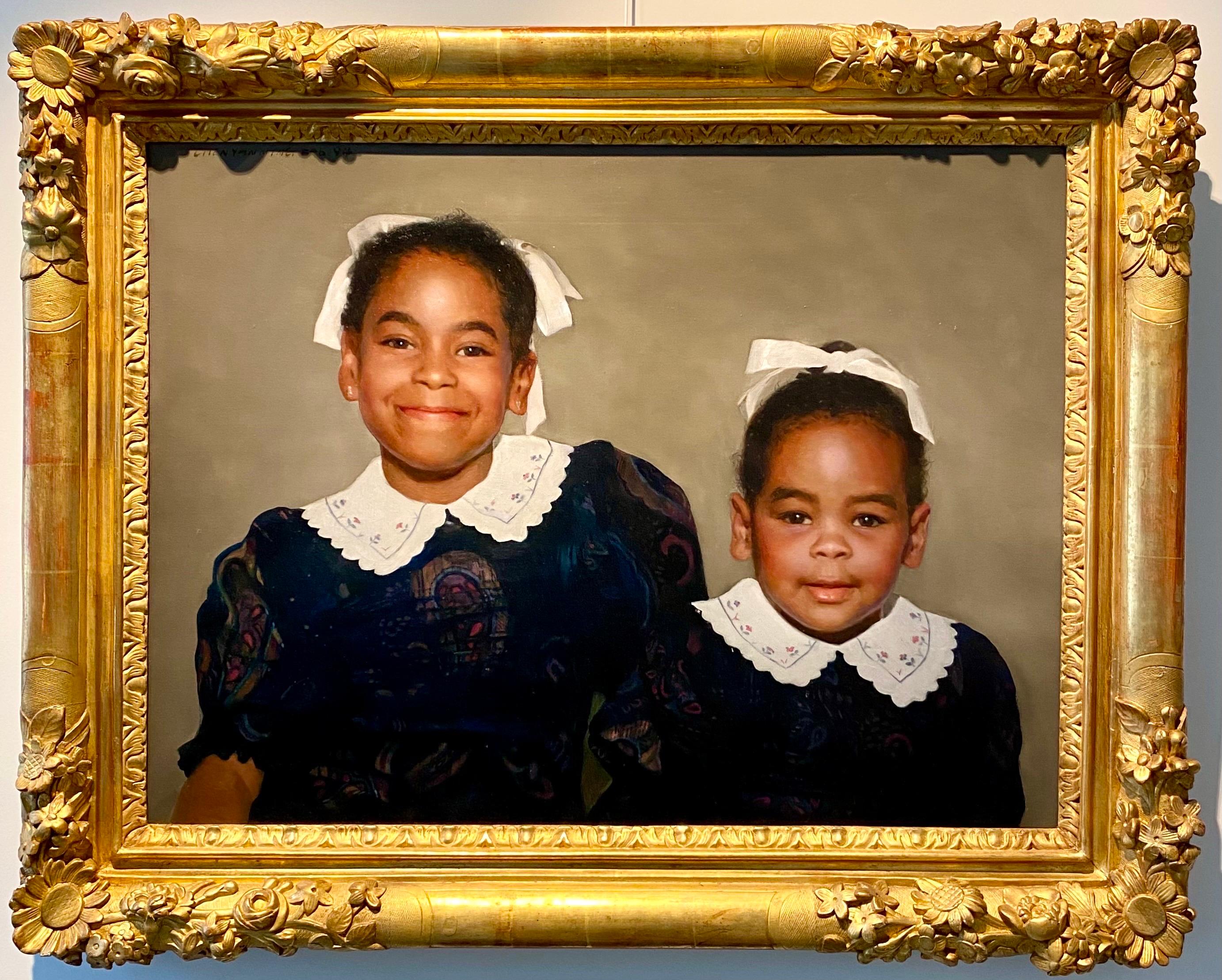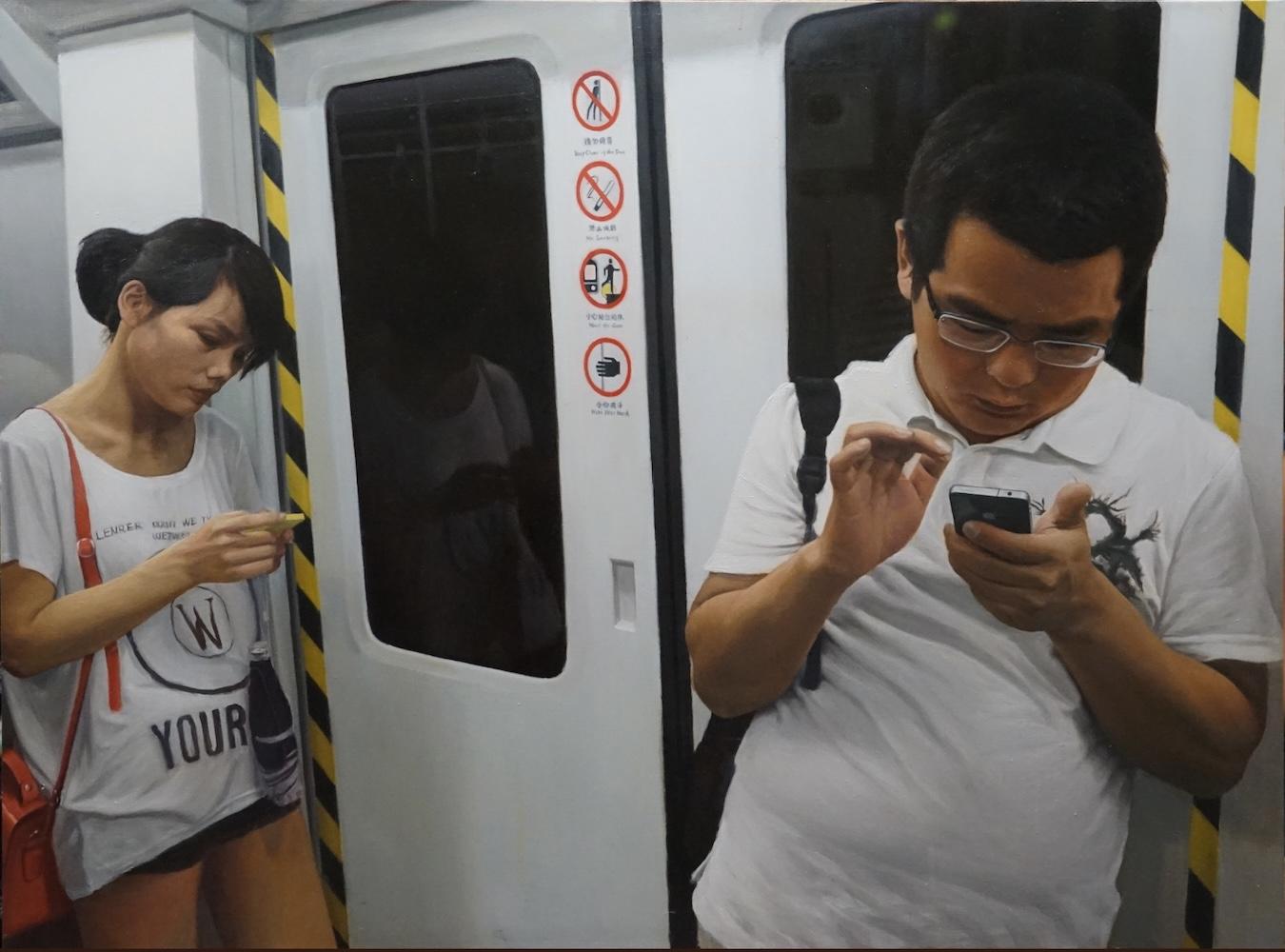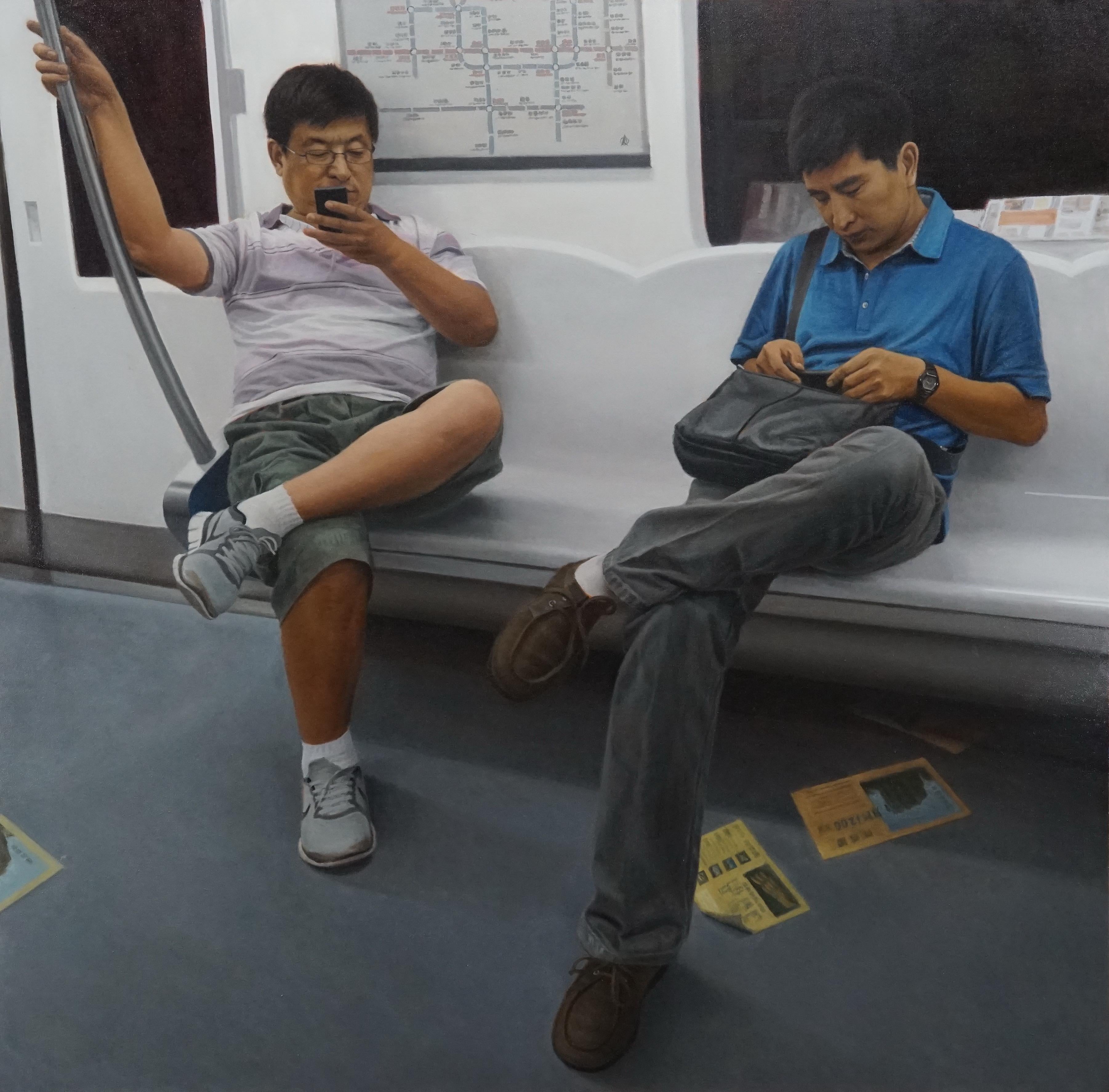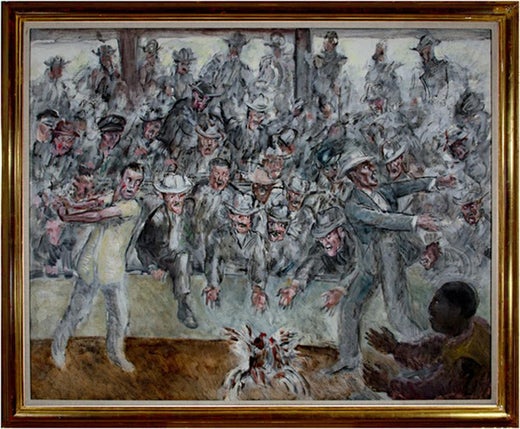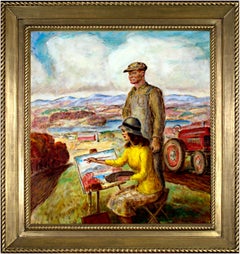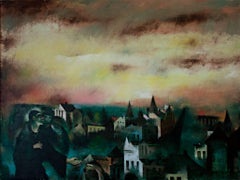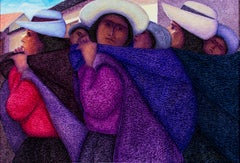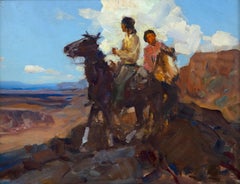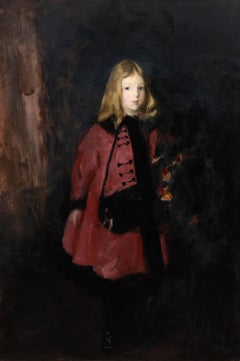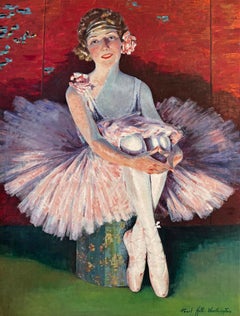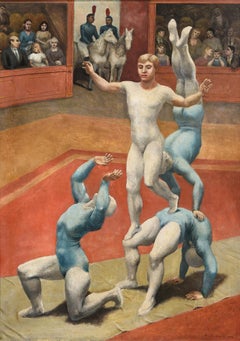
'Sketching Wisconsin' original oil painting signed by John Steuart Curry
View Similar Items
Want more images or videos?
Request additional images or videos from the seller
1 of 12
John Steuart Curry'Sketching Wisconsin' original oil painting signed by John Steuart Curry1946
1946
$610,000List Price
About the Item
- Creator:John Steuart Curry (1897-1946, American)
- Creation Year:1946
- Dimensions:Height: 39.75 in (100.97 cm)Width: 36.75 in (93.35 cm)Depth: 2.5 in (6.35 cm)
- Medium:
- Movement & Style:
- Period:
- Condition:
- Gallery Location:Milwaukee, WI
- Reference Number:Seller: 12694g1stDibs: LU60532956591
John Steuart Curry
Born in Dunavant, Kansas on November 14, 1897, John Steuart Curry became the youngest member of the famed "Benton-Wood-Curry trio" of Regional Painters of the early 20th-century American Scene movement. He gained a national reputation for his rural Kansas scenes. The artist focused on people who were down-to-earth, plain spoken, and self-reliant, and who made a living through hard physical labor. Curry executed murals dealing with land settlement and racial justice, and his works reflecting these themes are in the Capitol Building in Kansas, the University of Wisconsin, the United States Department of the Interior, and the United States Department of Justice. The artist quit high school and attended the Kansas City Art Institute and School of Design. He transferred to the Art Institute of Chicago. Curry married Clara Derrick in 1923. He studied in Paris in 1927. He was not impressed by the modernist American painters, many of whom were adopting the 'isms' of French contemporary artists. Curry was determined to paint American subjects without European models and to celebrate patriotism, regional pride, and the common man. He settled in Westport, Connecticut. In 1928, he painted Baptism in Kansas. The painting was heralded nationally as work of a new American genre. It was exhibited at the Corcoran Gallery of Art biennial where it met critical acclaim. In 1931, Gertrude Vanderbilt Whitney bought it for her museum. Tornado over Kansas was unveiled in 1929 before the stock market crash and provided the city with the romance of man versus nature theme. In 1933, it received second prize at the Carnegie International Exhibit. In 1930, he had his first one-man exhibition at the Whitney Studio Club. His work of the 1930s contains themes of work, family, and land-- demonstrating the peace, struggle, and perseverance that Curry believed was the essence of American life. In 1934 he married Kathleen Shepard. The United States government selected him to paint murals for the Department of Justice and the Department of Interior. He was appointed Artist-in-Residence in the College of Agriculture at the University of Wisconsin in 1936. He was a member of the Art Students' League and won prizes including: Purchase prize, North West Print Maker, fifth annual Exhibition, 1933; second prize, Thirty-first International Exhibition, Carnegie Institute, 1933; gold medal, PAFA, 1941; prize, Artists for Victory Exhibition, the Metropolitan Museum of Art, 1941. Exhibitions include: “A Celebration of Rural America,” 2007, Danville Museum of Fine Arts and History; “Collective Images: the sketchbooks of John Steuart Curry, 2002, Worcester Art Museum; “Illusions of Eden: Visions of the American Heartland,” 2000, Columbus Museum of Art; “The American Century: Art and Culture 1900-2000,” Whitney Museum of American Art; and “John Steuart Curry: Inventing the Middle West,” 1998, M.H. de Young Memorial Museum. He died in Madison, Wisconsin in 1946.
About the Seller
4.9
Platinum Seller
Premium sellers with a 4.7+ rating and 24-hour response times
Established in 1966
1stDibs seller since 2017
438 sales on 1stDibs
Typical response time: 3 hours
Authenticity Guarantee
In the unlikely event there’s an issue with an item’s authenticity, contact us within 1 year for a full refund. DetailsMoney-Back Guarantee
If your item is not as described, is damaged in transit, or does not arrive, contact us within 7 days for a full refund. Details24-Hour Cancellation
You have a 24-hour grace period in which to reconsider your purchase, with no questions asked.Vetted Professional Sellers
Our world-class sellers must adhere to strict standards for service and quality, maintaining the integrity of our listings.Price-Match Guarantee
If you find that a seller listed the same item for a lower price elsewhere, we’ll match it.Trusted Global Delivery
Our best-in-class carrier network provides specialized shipping options worldwide, including custom delivery.More From This Seller
View All'Sketching Wisconsin' original oil painting, Signed
By John Steuart Curry
Located in Milwaukee, WI
John Steuart Curry
"Sketching Wisconsin," 1946
oil on canvas
31.13 x 28 inches, canvas
39.75 x 36.75 x 2.5 inches, frame
Signed and dated lower right
Overall excellent condition
Presented in a 24-karat gold leaf hand-carved wood frame
John Steuart Curry (1897-1946) was an American regionalist painter active during the Great Depression and into World War II. He was born in Kansas on his family’s farm but went on to study art in Chicago, Paris and New York as young man. In Paris, he was exposed to the work of masters such as Peter Paul Rubens, Eugène Delacroix and Jacques-Louis David. As he matured, his work showed the influence of these masters, especially in his compositional decisions. Like the two other Midwestern regionalist artists that are most often grouped with him, Grant Wood (American, 1891-1942) and Thomas Hart Benton (American, 1889-1975), Curry was interested in representational works containing distinctly American subject matter. This was contrary to the popular art at the time, which was moving closer and closer to abstraction and individual expression.
Sketching Wisconsin is an oil painting completed in 1946, the last year of John Steuart Curry’s life, during which time he was the artist-in-residence at the University of Wisconsin in Madison. The painting is significant in Curry’s body of work both as a very revealing self-portrait, and as a landscape that clearly and sensitively depicts the scenery of southern Wisconsin near Madison. It is also a portrait of the artist’s second wife, Kathleen Gould Curry, and is unique in that it contains a ‘picture within a picture,’ a compositional element that many early painting masters used to draw the eye of the viewer. This particular artwork adds a new twist to this theme: Curry’s wife is creating essentially the same painting the viewer is looking at when viewing Sketching Wisconsin.
The triangular composition of the figures in the foreground immediately brings focus to a younger Curry, whose head penetrates the horizon line and whose gaze looks out towards the viewer. The eye then moves down to Mrs. Curry, who, seated on a folding stool and with her hand raised to paint the canvas on the easel before her, anchors the triangular composition. The shape is repeated in the legs of the stool and the easel. Behind the two figures, stripes of furrowed fields fall away gently down the hillside to a farmstead and small lake below. Beyond the lake, patches of field and forest rise and fall into the distance, and eventually give way to blue hills.
Here, Curry has subverted the traditional artist’s self-portrait by portraying himself as a farmer first and an artist second. He rejects what he sees as an elitist art world of the East Coast and Europe. In this self-portrait he depicts himself without any pretense or the instruments of his profession and with a red tractor standing in the field behind him as if he was taking a break from the field work. Here, Curry’s wife symbolizes John Steuart Curry’s identity as an artist. Compared with a self-portrait of the artist completed a decade earlier, this work shows a marked departure from how the artist previously presented and viewed himself. In the earlier portrait, Curry depicted himself in the studio with brushes in hand, and with some of his more recognizable and successful canvases behind him. But in Sketching Wisconsin, Curry has taken himself out of the studio and into the field, indicating a shift in the artist’s self-conception.
Sketching Wisconsin’s rural subject also expresses Curry’s populist ideals, that art could be relevant to anyone. This followed the broad educational objectives of UW’s artist-in-residence program. Curry was appointed to his position at the University of Wisconsin in 1937 and was the first person to hold any such position in the country, the purpose of which was to serve as an educational resource to the people of the state. He embraced his role at the University with zeal and not only opened the doors of his campus studio in the School of Agriculture to the community, but also spent a great deal of time traveling around the state of Wisconsin to visit rural artists who could benefit from his expertise. It was during his ten years in the program that Curry was able to put into practice his belief that art should be meaningful to the rural populace. However, during this time he also struggled with public criticism, as the dominant forces of the art market were moving away from representation. Perhaps it was Curry’s desire for public acceptance during the latter part of his career that caused him to portray himself as an Everyman in Sketching Wisconsin.
Beyond its importance as a portrait of the artist, Sketching Wisconsin is also a detailed and sensitive landscape that shows us Curry’s deep personal connection to his environment. The landscape here can be compared to Wisconsin Landscape of 1938-39 (the Metropolitan Museum of Art), which presents a similar tableau of rolling hills with a patchwork of fields. Like Wisconsin Landscape, this is an incredibly detailed and expressive depiction of a place close to the artist’s heart. This expressive landscape is certainly the result of many hours spent sketching people, animals, weather conditions and topography of Wisconsin as Curry traveled around the state. The backdrop of undulating hills and the sweeping horizon, and the emotions evoked by it, are emphatically recognizable as the ‘driftless’ area of south-central Wisconsin. But while the Metropolitan’s Wisconsin Landscape conveys a sense of uncertainty or foreboding with its dramatic spring cloudscape and alternating bands of light and dark, Sketching Wisconsin has a warm and reflective mood. The colors of the foliage indicate that it is late summer and Curry seems to look out at the viewer approvingly, as if satisfied with the fertile ground surrounding him.
The landscape in Sketching Wisconsin is also revealing of what became one of Curry’s passions while artist-in-residence at UW’s School of Agriculture – soil conservation. When Curry was a child in Kansas, he saw his father almost lose his farm and its soil to the erosion of The Dust Bowl. Therefore, he was very enthusiastic about ideas from UW’s School of Agriculture on soil conservation methods being used on Wisconsin farms. In Sketching Wisconsin, we see evidence of crop rotation methods in the terraced stripes of fields leading down the hillside away from the Curry’s and in how they alternate between cultivated and fallow fields.
Overall, Sketching Wisconsin has a warm, reflective, and comfortably pastoral atmosphere, and the perceived shift in Curry’s self-image that is evident in the portrait is a positive one. After his rise to favor in the art world in the 1930’s, and then rejection from it due to the strong beliefs presented in his art, Curry is satisfied and proud to be farmer in this self-portrait. Curry suffered from high blood...
Category
1940s American Realist Figurative Paintings
Materials
Canvas, Oil
'Cock Fight in Cuba' original Regionalist painting signed by John Steuart Curry
By John Steuart Curry
Located in Milwaukee, WI
John Steuart Curry
"Cockfight in Cuba," 1946
oil on canvas
Image: 38.25 x 46.25 in
Frame: 43.75 x 51.5 in
Signed on reverse with initials JSC on lower right stretcher bar
John Steu...
Category
1940s American Realist Figurative Paintings
Materials
Canvas, Oil
"The Saint of the Flaming City, " Oil on Canvas signed by Raymond Breinin
By Raymond Breinin
Located in Milwaukee, WI
"The Saint of the Flaming City" is an original oil painting on canvas by Raymond Breinin. It depicts a group of figures looking over an abstracted and green city as the colors of fire rage through the sky. The artist signed and dated the piece in the lower right. This painting was lent by the David Barnett Gallery to the Art Institute of Chicago for their 52nd Annual Exhibition.
30" x 40" art
39 3/4" x 49 3/4" frame
Raymond Breinin, Russian/American painter & designer (1910-2000), was born in Vitebsk, Russia, where he commenced his art studies with Uri Pen (who was also the first teacher of Marc Chagall) and later attended the Vitebsk Academy of Art where Malevitch was the director. He came to the United States with his family in 1922. When he came to America he attended classes at the Art Institute of Chicago and the Chicago Academy of Fine Arts.
A painter of murals for the WPA, he was invited to join the Downtown Gallery in New
York City, one of the foremost galleries at the time, where he exhibited in one man shows and group shows over a period of 18 years. The winner of numerous major prizes at the Chicago Art Institute and other museums, he also won the $1000 purchase prize at the Metropolitan Museum of Art's "Artists for Victory" exhibition. He designed the sets and costumes for Anthony Tudor's ballet, "Undertow" produced by the American Ballet Theater. He executed commissions for "Life", "Fortune" and "Redbook" magazines, for the Capehart Corporation, Eli Lilly...
Category
1940s Expressionist Landscape Paintings
Materials
Canvas, Oil
Contemporary figurative textured oil painting women street colorful signed
By Ernesto Gutierrez (b.1941)
Located in Milwaukee, WI
"Tres Madres" is an original oil painting on canvas by Ernesto Gutierrez. The artist signed the piece lower right. It depicts three mothers in Peruvian dress carrying small children ...
Category
Early 2000s Contemporary Figurative Paintings
Materials
Canvas, Oil
"Lake Michigan Beach Scene, " Oil on Canvas Seascape signed by Francesco Spicuzza
By Francesco Spicuzza
Located in Milwaukee, WI
"Lake Michigan Beach Scene" is an original oil painting by Francesco Spicuzza. The artist painted this scene on canvas and then glued that canvas to a b...
Category
1930s Figurative Paintings
Materials
Canvas, Oil, Board
"Russian Village Scene, " Original Oil on Canvas signed by Olga Vasilevlkay
By Olga Vasilevlkay
Located in Milwaukee, WI
"Russian Village Scene" is an original oil painting on canvas by Olga Vasilevlkay. The artist signed the painting in the lower right. This piece depict...
Category
1980s Figurative Paintings
Materials
Canvas, Oil
You May Also Like
Scouting
By Frank Tenney Johnson
Located in Palm Desert, CA
"Scouting" is an oil on canvas painting by Frank Tenney Johnson. The framed piece measures 23 3/4 x 27 3/4 x 3 1/4 inches.
Johnson was well-known for his work of the American west, particularly for his portrayal of cowboys at night, lit by moonlight. Johnson utilized knives and fingers when painting, so his work is recognizable for its distinctive marks.
Provenance:
Biltmore Galleries, Scottsdale...
Category
Early 20th Century American Realist Landscape Paintings
Materials
Canvas, Oil
$65,000
Girl with Muff
By Robert Henri
Located in Palm Desert, CA
"Girl with Muff" is aa American figurative portrait oil on canvas painting by Robert Henri in 1912. The artwork is 57 1/4 x 38 1/4 inches and, with the frame, is 64 1/4 x 45 1/4 x 2 ...
Category
Early 20th Century American Realist Portrait Paintings
Materials
Canvas, Oil
$950,000
Blond and Blue Eyed Ballerina in Tutu against Chinese Screen
Located in Miami, FL
Prolific Saturday Evening Post Cover Illustrator Pearl L. Hill Worthington paints a stunning portrait of a Ballerina in a tutu with underlighting. She sits on a decorative Chinese ...
Category
1920s American Realist Portrait Paintings
Materials
Canvas, Oil
$20,800 Sale Price
20% Off
Circus Acrobats - ( Friends with Diego Rivera and Frida Kahlo )
Located in Miami, FL
As they take center stage, four acrobats are depicted, forming an architectural structure composed of contorted human bodies. The small gallery of onlookers displays a variety of ex...
Category
1930s American Realist Figurative Paintings
Materials
Canvas, Oil
Black Angel - African American Artist - Black Artist
Located in Miami, FL
This powerful and graphically composed image of a black man with white angel wings was painted in a realist style by African American artist Thomas Blackshear...
Category
Early 2000s American Realist Portrait Paintings
Materials
Canvas, Oil, Board
Film Still #4 (portrait, western movie, cowboy, Hat, shadow, monochrome art)
By Rudolf Kosow
Located in Quebec, Quebec
With eyes obscured and hat lowered, this figure is both iconic and unknowable—a faceless cowboy adrift in a pale, open void. Kosow distills the visual codes of Americana and cinemati...
Category
2010s American Realist Figurative Paintings
Materials
Canvas, Oil
